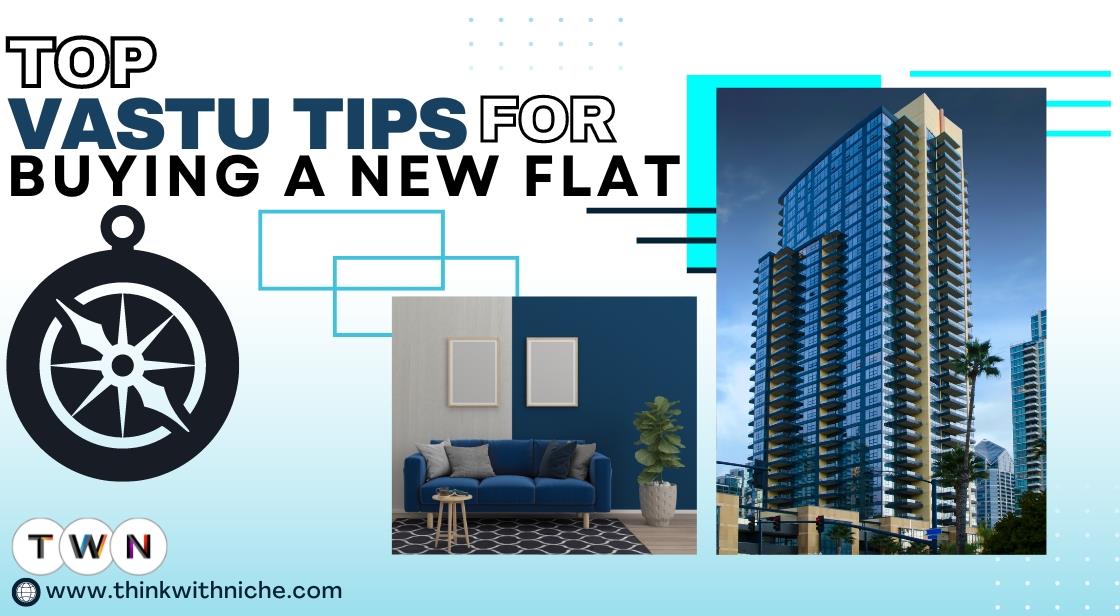Top Vastu Tips for Buying a New Flat

Blog Post
Vastu Shastra, an ancient Indian science of architecture, offers a holistic approach to designing living spaces that promote well-being, prosperity, and harmony. By aligning your home with the principles of Vastu, you can create an environment that positively influences your life.
This comprehensive guide delves into the core principles of Vastu Shastra, explaining how to apply them when buying a new flat. From understanding the significance of direction, shape, and layout to incorporating color and design elements, we provide practical tips to help you make informed decisions.
We explore the importance of different areas within your home, such as the kitchen, bedroom, and bathroom, and how their placement can impact your overall well-being. Additionally, we discuss the significance of water bodies, the main entrance, and the overall energy flow within your living space.
While modern architecture may deviate from traditional Vastu principles, this guide offers insights into how you can incorporate elements of Vastu to enhance your home's positive energy. Remember, the goal is to create a living space that resonates with your personal preferences while also aligning with the principles of harmony and balance.
By understanding the underlying concepts of Vastu Shastra and applying them thoughtfully, you can transform your home into a sanctuary that supports your physical, mental, and spiritual well-being.
A Comprehensive Guide to Vastu Tips for Buying a New Apartment
Understanding Vastu Shastra: A Holistic Approach to Living
Vastu Shastra, an ancient Indian system of architecture, goes beyond mere building design. It is a comprehensive philosophy that seeks to harmonize human habitation with the laws of nature. Rooted in the Vedic scriptures, Vastu explores the interplay of the five elements - earth, water, fire, air, and space - to create environments that promote physical, mental, and spiritual well-being.
Core Principles of Vastu Shastra
At the heart of Vastu Shastra lie several fundamental principles:
-
Alignment with Natural Forces: Vastu emphasizes aligning buildings with the cardinal directions to optimize the influence of sunlight, wind, and cosmic energies.
-
Balance of Elements: The five elements should be present in harmonious proportions within a space. For example, a water body or a fountain can introduce the water element.
-
Energy Flow: The internal layout of a building should facilitate smooth circulation of energy, avoiding obstructions and negative corners.
-
Zones of Influence: Different areas of a home are associated with specific energies and functions. The placement of rooms should be in accordance with these zones.
-
Spiritual Well-being: Vastu considers the spiritual aspects of living, creating spaces that promote peace, tranquility, and positive energy.
Practical Applications of Vastu Shastra
Incorporating Vastu principles into modern living can be achieved through thoughtful planning and design. Here are some key considerations:
-
Site Selection: Choose a plot of land that is square or rectangular in shape, with a gentle slope towards the east or north.
-
Orientation: The main entrance should ideally face east or north to welcome positive energy.
-
Room Placement: The master bedroom should be in the southwest corner for stability, while the kitchen is best suited for the southeast.
-
Color Palette: Opt for colors that resonate with the desired energy of each room. For instance, calming blues and greens for bedrooms and vibrant hues for living areas.
-
Ventilation and Lighting: Prioritize natural light and ventilation to create a healthy indoor environment.
Beyond the Basics
Vastu Shastra encompasses a broader spectrum of guidelines, including:
-
Furniture Placement: Arranging furniture to optimize energy flow and avoid obstructing pathways.
-
Landscaping: Incorporating plants and water bodies to enhance the natural environment.
-
Spiritual Spaces: Creating dedicated areas for meditation or prayer.
By understanding and applying the core principles of Vastu Shastra, individuals can create living spaces that are not only aesthetically pleasing but also contribute to their overall well-being. While modern architecture may present challenges, incorporating Vastu elements can be achieved through thoughtful planning and design.
Also Read : Top Interior Design Ideas for Home Decor
Why Is Vastu Important?
Vastu Shastra is more than just an architectural guideline; it is a holistic approach to creating living spaces that promote well-being and harmony. Rooted in the ancient Indian wisdom of aligning human habitation with natural forces, Vastu offers a comprehensive framework for designing homes that foster physical, mental, and spiritual balance.
The Science Behind Vastu
While often perceived as mystical, Vastu Shastra has scientific underpinnings. It recognizes the influence of the sun, earth, water, air, and space on human life. By optimizing the placement of buildings and their interiors, Vastu aims to harness these natural energies positively.
-
Energy Flow: Vastu emphasizes the importance of unobstructed energy flow within a space. This is linked to the concept of 'prana' or life force, which is believed to enhance vitality and positivity.
-
Directional Alignment: The orientation of a building influences the amount of sunlight, ventilation, and cosmic energy it receives. Vastu suggests specific directions for different rooms to maximize their benefits.
-
Balance of Elements: The five elements - earth, water, fire, air, and space - are believed to interact within a space. Vastu seeks to create a harmonious balance between these elements for optimal well-being.
Benefits of Following Vastu
Adhering to Vastu principles can lead to several benefits:
-
Improved Health: A Vastu-compliant home is believed to promote physical and mental health by creating a positive and balanced environment.
-
Enhanced Relationships: Harmonious energy flow within a home can foster better relationships among family members.
-
Financial Prosperity: Vastu principles are associated with attracting wealth and abundance.
-
Spiritual Growth: By creating a space that aligns with natural rhythms, Vastu can support spiritual growth and inner peace.
-
Reduced Stress: A well-designed Vastu home can contribute to a calmer and more relaxed atmosphere, reducing stress and anxiety.
While modern architecture often deviates from traditional Vastu principles, incorporating some of its key concepts can still create a more harmonious living space. It is essential to approach Vastu with an open mind and consider it as a complementary approach to interior design and architecture.
By understanding the underlying principles of Vastu and making conscious choices in home design, individuals can create spaces that not only look beautiful but also contribute to their overall well-being.
Vastu Tips for Buying a New Flat
When buying a new flat, consider the following Vastu tips to ensure that the property you choose aligns with these ancient principles:
1.The Significance of Orientation in Vastu for Flat Selection
The direction a flat faces is a cornerstone of Vastu Shastra. This orientation significantly influences the energy flow within the dwelling and, consequently, the well-being of its inhabitants.
The Auspicious Directions
-
North-Facing Flats: Generally considered the most auspicious direction, north-facing flats are believed to attract wealth, prosperity, and good fortune. The abundant natural light and positive energy flow associated with this orientation contribute to a harmonious living environment.
-
East-Facing Flats: East is another favorable direction, symbolizing new beginnings and growth. Residents of east-facing flats are often believed to enjoy good health, success, and overall positivity.
The Less Auspicious Directions
-
South-Facing Flats: While not entirely inauspicious, south-facing flats are generally considered less preferred due to the association of south with the Pitra (ancestor) direction. However, with proper Vastu remedies, the negative impacts can be mitigated.
-
West-Facing Flats: Similar to south-facing flats, west-facing flats are also considered less ideal. The setting sun's heat can be intense, and certain Vastu principles suggest potential challenges in maintaining a cool and balanced environment.
It's important to note that while direction is a crucial factor, other Vastu principles and the overall layout of the flat also play a significant role in determining its suitability.
2.The Significance of Plot Shape in Vastu Shastra
The shape of a plot is a crucial determinant of the energy flow and overall harmony of a dwelling, according to Vastu Shastra.
Ideal Plot Shapes
-
Square Plot: A square plot is considered the most auspicious in Vastu. It symbolizes balance, stability, and equality. Such plots are believed to promote harmony and prosperity for the inhabitants.
-
Rectangular Plot: A rectangular plot is also considered favorable, especially if the length-to-width ratio is around 1:1.5 or 1:2. This shape facilitates efficient space utilization and energy distribution.
Avoiding Irregular Shapes
-
Triangular Plots: These are generally considered inauspicious due to the sharp corners, which are believed to disrupt energy flow and create negative influences.
-
Circular or Oval Plots: While aesthetically pleasing, these shapes are not ideal from a Vastu perspective as they can lead to imbalances in energy distribution.
-
Irregular Shapes: Plots with multiple corners or extensions are generally avoided as they can create energy blockages and negative zones.
The Rationale Behind Shape Preferences
The preference for square and rectangular plots stems from the belief that these shapes represent stability, balance, and harmony. The smooth flow of energy within these geometric forms is seen as conducive to positive living conditions. Irregular shapes, on the other hand, can create energy imbalances and negative corners, impacting the well-being of the inhabitants.
By carefully considering the shape of a plot, potential homeowners can lay a strong foundation for a harmonious and prosperous living space.
3. The Significance of Building Shape in Vastu Shastra
The shape of a building plays a crucial role in Vastu Shastra, influencing the energy flow and overall ambiance of a space. While modern architecture often deviates from traditional Vastu principles, understanding these guidelines can help in creating a more harmonious living environment.
Ideal Building Shapes
-
Square or Rectangular: These shapes are considered most auspicious in Vastu. They represent balance, stability, and harmony. A square building is often seen as the epitome of Vastu compliance, while a rectangle should ideally have a length-to-width ratio of 1:1.5 or 1:2.
-
Gaumukhi Shape: Resembling the shape of a cow's face, with a wider back and narrower front, this shape is considered beneficial for residential properties. It is believed to promote prosperity and well-being.
Buildings Shapes to Avoid
-
Triangular Shape: Buildings with triangular shapes are generally discouraged due to the sharp corners, which can disrupt energy flow and create negative zones.
-
Circular or Oval Shape: While aesthetically pleasing, these shapes are not considered ideal in Vastu as they can lead to imbalances in energy distribution.
-
Irregular Shapes: Buildings with complex or irregular shapes often create energy blockages and are generally avoided.
The Rationale Behind Shape Preferences
The preference for square or rectangular shapes stems from the belief that these forms facilitate smooth energy circulation. The corners of a building are considered crucial, and their alignment with the cardinal directions influences the overall energy dynamics. By adhering to these guidelines, one can create a space that promotes positive energy, harmony, and well-being.
It's important to note that while Vastu provides valuable insights, modern architectural constraints might necessitate deviations from traditional shapes. In such cases, incorporating Vastu principles through interior design and other means can still be beneficial.
4. The Significance of Color and Design in Vastu Shastra
The choice of colors and interior design plays a crucial role in creating a harmonious and positive living space according to Vastu Shastra.
The Psychology of Color in Vastu
-
Light Colors: Vastu emphasizes the use of light colors like white, cream, yellow, and light shades of green and blue. These colors are believed to promote positivity, optimism, and a sense of spaciousness.
-
Dark Colors: While dark colors can be aesthetically appealing, they are generally discouraged in Vastu as they can create a heavy and oppressive atmosphere. However, judicious use of dark colors in specific areas can be considered.
-
Balancing Elements: It's essential to balance the use of colors. For instance, a predominantly white room can be livened up with accents of brighter colors.
Interior Design and Energy Flow
-
Clutter-Free Spaces: Vastu emphasizes the importance of a clutter-free environment. Clutter is believed to obstruct the flow of positive energy.
-
Furniture Placement: The arrangement of furniture should allow for smooth movement and avoid creating obstructions.
-
Natural Light and Ventilation: Ample natural light and good ventilation are crucial for a positive living space.
-
Art and Decor: Choose artwork and decorative items that evoke positive emotions and align with your personal preferences.
Specific Room Considerations
-
Living Room: Opt for bright and cheerful colors to promote social interaction and positive energy.
-
Bedroom: Choose calming colors like light blue, green, or beige to create a restful atmosphere.
-
Kitchen: Use vibrant colors like orange or red to stimulate appetite but avoid excessive use of black.
-
Bathroom: Light colors are preferred for bathrooms to create a clean and hygienic atmosphere.
By carefully considering color schemes and interior design elements based on Vastu principles, you can create a living space that is not only aesthetically pleasing but also contributes to your overall well-being.
5. Strategic Placement of Key Areas in Vastu Shastra
The placement of essential areas within a home significantly influences the energy flow and overall well-being of its inhabitants, according to Vastu Shastra.
The Kitchen: The Heart of the Home
-
Ideal Location: The southeast corner is considered the most auspicious for the kitchen as it is associated with the fire element.
-
Stove Placement: The cooking stove should ideally be located in the southeast corner of the kitchen.
-
Sink Placement: The sink should be placed in the northeast corner, symbolizing the water element.
The Bathroom: A Water Element Zone
-
Location: Bathrooms are typically placed in the northwest or northeast corners of a building. However, the northwest corner is generally preferred.
-
Ventilation: Adequate ventilation is crucial to dissipate dampness and negative energy.
-
Avoidance: Bathrooms should not be directly adjacent to the kitchen or puja room.
The Main Entrance: The Gateway to Positive Energy
-
Ideal Directions: The main entrance should preferably face north or east to welcome positive energy into the home.
-
Avoidance: South and west-facing entrances are generally considered less favorable.
-
Energy Flow: The entrance should be well-lit and spacious to facilitate smooth energy flow.
Staircases: A Structural Consideration
-
Location: If present, staircases should ideally be located in the south or west corner of the building.
-
Direction: The staircase should ascend in a clockwise direction.
By carefully considering the placement of these key areas, homeowners can create a harmonious and balanced living environment that promotes well-being and prosperity. It's essential to remember that while Vastu provides guidelines, individual preferences and practical considerations should also be taken into account.
6.The Significance of Water Bodies in Vastu Shastra
The placement of water bodies in relation to a dwelling is a crucial aspect of Vastu Shastra. Water, as one of the five elements, holds significant importance in creating a harmonious living environment.
The Ideal Placement of Water Bodies
-
Northeast Corner: This is the most auspicious location for water bodies. It is associated with the water element and is believed to bring prosperity, health, and abundance.
-
Other Locations: While the northeast is preferred, water bodies in other directions can be accommodated with certain adjustments to mitigate potential imbalances.
The Negative Impact of Improper Placement
-
South and West Directions: Placing large water bodies in the south or west is generally discouraged as it can lead to an imbalance of elements and create negative energy.
-
Disruption of Energy Flow: The presence of water bodies in these directions can disrupt the harmonious flow of energy within the dwelling.
Practical Considerations
While Vastu principles offer valuable guidance, it's essential to consider practical factors such as the availability of water bodies and the overall landscape. In modern urban settings, large water bodies within residential plots might not be feasible. However, incorporating water elements like fountains, aquariums, or even water plants can still be beneficial.
7.The Kitchen: Heart of the Home in Vastu Shastra
The kitchen holds significant importance in Vastu Shastra as it is considered the heart of the home, symbolizing nourishment and abundance. Its placement and orientation directly influence the overall well-being of the household.
Ideal Placement for the Kitchen
-
Southeast Corner: This is the most preferred location for the kitchen as it aligns with the fire element, essential for cooking. It is believed to promote good health, digestion, and prosperity.
-
Northwest Corner: If the southeast corner is unavailable, the northwest can be a suitable alternative. However, it is essential to ensure proper ventilation to counterbalance the potential imbalance of elements.
Key Considerations for Kitchen Placement
-
Avoidance of North and Northeast: These directions are associated with water and are not considered ideal for the kitchen.
-
Proximity to Main Door: The kitchen should not be directly visible from the main entrance.
-
Ventilation: Adequate ventilation is crucial to remove smoke, odors, and heat.
Additional Tips
-
Stove Placement: The stove should ideally be located in the southeast corner of the kitchen.
-
Sink Placement: The sink is best positioned in the northeast corner, symbolizing the water element.
-
Kitchen Layout: A triangular layout with the stove, sink, and refrigerator forming the vertices is often considered auspicious.
By following these guidelines, you can create a kitchen that not only functions efficiently but also contributes to the overall harmony of your home.
8. Vastu Shastra for Main Entrance
The main entrance, often referred to as the 'mukhya dwaar' in Vastu, is considered the gateway through which positive energy enters a home. Its placement and orientation significantly impact the overall energy flow and prosperity of the dwelling.
Ideal Directions for the Main Entrance
-
North-East (Eshanya): This is considered the most auspicious direction for the main entrance. It symbolizes new beginnings, prosperity, and good health.
-
North: The north direction is also considered favorable, associated with wealth and abundance.
-
East: While not as ideal as north or northeast, an east-facing entrance can still be considered auspicious.
Less Preferred Directions
-
South: A south-facing main door is generally avoided as it is associated with the Pitra (ancestor) direction. However, with proper Vastu remedies, its negative impact can be mitigated.
-
West: Similar to south, the west direction is also less preferred for the main entrance.
Factors to Consider Beyond Direction
-
Door Material and Design: The material and design of the main door also influence energy flow. Wood is often preferred, and the door should be sturdy and well-maintained.
-
Door Color: The color of the main door should be auspicious and inviting. Colors like yellow, orange, and green are often considered favorable.
-
Entrance Area: The area around the main door should be well-lit, clean, and free of clutter to facilitate smooth energy flow.
By carefully considering these factors, you can create a welcoming and auspicious entrance to your home that invites positive energy and prosperity.
9. The Bedroom: A Haven of Rest and Renewal
The bedroom is considered a sanctuary, a place for relaxation and rejuvenation. Its placement within a home according to Vastu principles is crucial for promoting restful sleep and overall well-being.
Ideal Placement for the Bedroom
-
Southwest Corner: This is the most preferred location for the master bedroom as it represents stability and grounding. It is believed to promote deep sleep, emotional balance, and a sense of security.
-
Other Suitable Locations: While southwest is optimal, bedrooms in the south or west directions can also be considered, provided they adhere to other Vastu principles.
Factors to Avoid
-
Northeast and Southeast: These directions are generally not recommended for bedrooms as they are associated with energy and activity.
-
Under Beams: Avoid placing the bed directly under a beam, as it is believed to create psychological pressure.
Additional Considerations
-
Bed Placement: The head of the bed should ideally be positioned towards the south or east. This alignment is believed to promote restful sleep and positive energy flow.
-
Bedroom Orientation: If possible, the bedroom should receive morning sunlight, which is considered auspicious.
-
Clutter-Free Environment: A clean and clutter-free bedroom is essential for a peaceful atmosphere.
10. Bathrooms and Toilets: Key Considerations in Vastu Shastra
Bathrooms and toilets, while essential, are considered areas that require careful placement according to Vastu principles to maintain overall energy balance within a home.
Ideal Placement of Bathrooms and Toilets
-
Northwest Corner: This is the preferred location for bathrooms and toilets. It is associated with the element of water and is believed to facilitate the smooth flow of waste.
-
Southeast Corner: While not as ideal as the northwest, the southeast can also accommodate bathrooms and toilets. However, proper ventilation and cleanliness are essential.
Areas to Avoid
-
Northeast Corner: This corner is associated with the elements of water and air and is considered inauspicious for bathrooms and toilets.
-
Directly Adjacent to Puja Room or Kitchen: Bathrooms and toilets should not be located adjacent to these sacred or food preparation areas.
Additional Considerations
-
Ventilation: Proper ventilation is crucial to eliminate dampness and odors.
-
Cleanliness: Maintaining cleanliness and hygiene in bathrooms and toilets is essential for preventing negative energy build-up.
-
Toilet Seat Direction: The toilet seat should not face north, south, or east.
-
Color Palette: Light colors are generally preferred for bathrooms to create a sense of cleanliness and hygiene.
By adhering to these Vastu guidelines, you can minimize the negative impact of bathrooms and toilets on the overall energy of your home.
Implications of Non-Vastu Compliance
Non-compliance with Vastu principles can lead to disruptions in energy flow, potentially affecting the overall well-being of the inhabitants. Issues may include increased stress, strained relationships, and financial challenges. While Vastu Shastra does not guarantee a problem-free life, aligning your home with its principles can foster a balanced and harmonious living space.
Conclusion
Incorporating Vastu Shastra principles into your home-buying process can create a space that resonates with positive energies and enhances overall well-being. By paying attention to orientation, shape, and placement, you can ensure that your new flat supports a prosperous and harmonious lifestyle. Even if you are skeptical about Vastu, considering these tips can add a thoughtful dimension to your home selection process.
You May Like
EDITOR’S CHOICE












